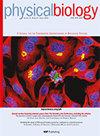评论“集体动物行为的物理学视角”2022Phys。Biol.19 021004。
IF 2
4区 生物学
Q4 BIOCHEMISTRY & MOLECULAR BIOLOGY
引用次数: 2
摘要
在他富有洞察力和及时的评论中,Ouellette(2022年)。Biol.19021004)指出了在理解和模拟集体动物行为方面取得进展的三个理论障碍。在这里,通过新颖的分析和借鉴最新的研究,我展示了如何克服或消除这些障碍。我认为集体行为物理学的最新进展提供了重要的生物信息。本文章由计算机程序翻译,如有差异,请以英文原文为准。
Comment on 'A physics perspective on collective animal behavior' 2022Phys. Biol.19 021004.
In his insightful and timely review Ouellette (2022Phys. Biol.19021004) noted three theoretical impediments to progress in understanding and modelling collective animal behavior. Here through novel analyses and by drawing on the latest research I show how these obstacles can be either overcome or negated. I suggest ways in which recent advances in the physics of collective behavior provide significant biological information.
求助全文
通过发布文献求助,成功后即可免费获取论文全文。
去求助
来源期刊

Physical biology
生物-生物物理
CiteScore
4.20
自引率
0.00%
发文量
50
审稿时长
3 months
期刊介绍:
Physical Biology publishes articles in the broad interdisciplinary field bridging biology with the physical sciences and engineering. This journal focuses on research in which quantitative approaches – experimental, theoretical and modeling – lead to new insights into biological systems at all scales of space and time, and all levels of organizational complexity.
Physical Biology accepts contributions from a wide range of biological sub-fields, including topics such as:
molecular biophysics, including single molecule studies, protein-protein and protein-DNA interactions
subcellular structures, organelle dynamics, membranes, protein assemblies, chromosome structure
intracellular processes, e.g. cytoskeleton dynamics, cellular transport, cell division
systems biology, e.g. signaling, gene regulation and metabolic networks
cells and their microenvironment, e.g. cell mechanics and motility, chemotaxis, extracellular matrix, biofilms
cell-material interactions, e.g. biointerfaces, electrical stimulation and sensing, endocytosis
cell-cell interactions, cell aggregates, organoids, tissues and organs
developmental dynamics, including pattern formation and morphogenesis
physical and evolutionary aspects of disease, e.g. cancer progression, amyloid formation
neuronal systems, including information processing by networks, memory and learning
population dynamics, ecology, and evolution
collective action and emergence of collective phenomena.
 求助内容:
求助内容: 应助结果提醒方式:
应助结果提醒方式:


